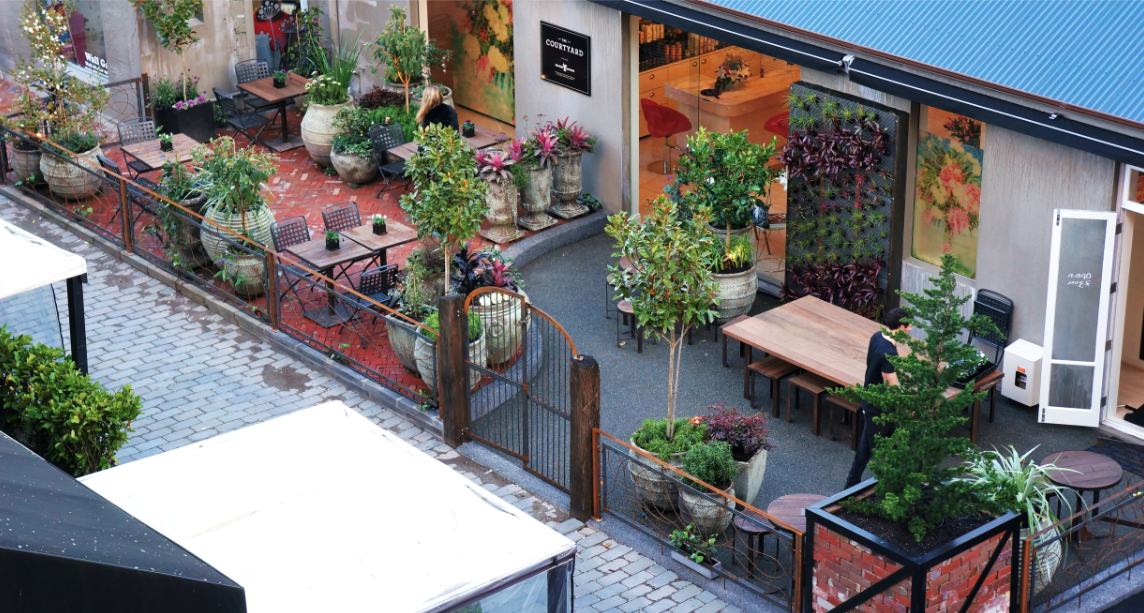
Well-planned garden design enhances appearance and adds value to a home. It offers substantial benefits to the home owner’s enjoyment of their property and this tangible connection with nature helps boost a sense of wellbeing.
A self-employed landscaper of 35 years, Chris formed Second Nature Landscapes in 1996 and in 2006 Janet Clarke, who was originally a client of Second Nature, partnered in the business.
Chris says, “Janet believed Second Nature delivered a great product but, like so many small, passion-based businesses, would benefit from a more strategic and disciplined business approach. The combination of my enthusiasm and experience as a landscape gardener, and Janet’s business acumen, has seen Second Nature grow significantly.”
“With a staff of 40, we specialise in design, installation and maintenance of professionally designed gardens. We work on a range of projects from lifestyle blocks to small city courtyards.”
Good landscape design is about getting the balance right. Interconnection of each of the parts – design, construction, and function do not effectively exist independently of the whole.Critical to any successful garden development is a well thought out landscape plan. A professional garden designer will bring fresh eyes, knowledge and experience to the process. They understand how outdoor spaces are best utilised, and how to create interest. A good garden planner will choose the right plants and develop workable concepts to suit the garden’s aspect and location and most importantly, meet the client’s needs.

Various concrete construction methods and finishes are cleverly combined to create strong architectural forms. Design by Sally McLeay. Implementation by Second Nature Landscaping.
Chris explains, “Once a concept plan is created, we present it to the client for comment. From the feedback the client gives us, the plan is finalised, and a cost is put to the scope of work. If the client is seeking more than one quote, a plan should be detailed enough to ensure ‘apples-for-apples’ costs are achieved. Professional landscape work can be an expensive exercise. Clients should always check the credentials of the contractor chosen to undertake the work and talk to previous clients.
A successful outcome as with the Freeman’s Bay ‘pool project’, where a backyard was transformed from an unattractive and rarely used backyard to a resort-like playground and entertainment space, requires a solid and trusted team of in-house and independent professional tradespeople to complete the job. The designer can be commissioned to supervise the work to ensure high standards are met.
Second Nature’s in-house design team collaborates with independent garden design professionals. The Freeman’s Bay ‘pool project’ is one that Second Nature built, but was designed by landscape architect, Richard Tyler.
The change of seasons will challenge even the most well-planned garden, and no more so than in winter. A winter garden must rely on good drainage systems, solid structural planting and building design elements that will see it through this period.
Gardens look downright dowdy during winter. They become saturated with rain and bathed in low light.
“It is important that paths and patios provide year-round easy and safe access, with careful consideration given to gradients and slip hazards,” advises Chris. “In summer we seek shade and, as the weather cools, shelter and warmth become all important, particularly if the intention is to use the garden and outdoor spaces all year round.

A clever combination of built elements and plant material create a dramatic effect. Design by Trish Bartlee.
“Adjustable shade structures and roofed pergolas can be used to create outdoor rooms that provide protection from the elements and encourage alfresco living. Furniture, fires and pizza ovens invite people to use the living space and will considerably extend the season for outdoor entertaining.”
Biodiversity is important – a diverse garden meets the needs of humans as well as the needs of the garden itself and what grows in it. It’s getting the balance right.
Chris says, “Good landscape will complement the architecture and interior design of the house, especially when design themes flow seamlessly between the interior and the exterior of the home. View lines are enhanced, colours and design themes are unified. The garden should invite use as a space to entertain, to relax with a morning coffee or an evening wine, to play and perhaps produce home-grown fruit and vegetables.
“With small urban gardens, clever design becomes even more critical. New Zealanders are beginning to appreciate good design, realising best results are achieved by getting professionals to design and build their outdoor spaces.”
“Living in urban city apartments often means minimal or no garden space. This can lead to a disconnection with nature, and people become devoid of the healing and calming properties nature provides.”

Design by Sally McLeay Strong geo-metric structures and mass plantings create dramatic effect. Implemented by Second Nature.
It is no wonder then, the desire to connect with nature is making a comeback. Food production is enjoying renewed popularity; people want a tangible connection to their food. Urban gardens can provide this sense of connection with natural processes – soil, plants and animals.
Lost in urbanisation are pollinators – bees and other insects.
Ever more popular are vertical wall gardens. They are a great option to grow vegetables in small spaces. Good drainage and high-quality soil are the core elements to achieving a successful food garden. Second Nature work hard to get the soil to an environmentally safe level and, in the main, use environmentally safe products.
With the decline of our bee population and other insects, it is important to grow plants for pollination. This can be achieved in any sized garden. Chris says they have done several wild-flower plantings in standard urban sections and bigger rural land areas. The results are very pretty and the attraction for insects immense – the garden hums with life.

Tropical plantings beautifully frame the entrance to this home. Implemented by Second Nature. Design by Shafer Design.
A garden that brims with life is therapeutic and should invite you to play. Whether you pursue passive or active play, a garden is your sanctuary.
The introduction of sculptural elements with a strong focus, acts as a centre point and they have a profound effect on the garden and those who use it. Sculptural pieces are not necessarily static, some are alive. They move, with reflective surfaces giving shadow and light which adds a positive dimension to your garden experience.
Chris says, “The garden often provides the critical first-impression to perspective buyers and so it is important that it be visually inviting and unified. The spaces ought to be coherent and ‘make sense’ and outdoor structures thoughtfully designed and well built. The quality of the home and its interior should be reflected in the garden.”
He adds, “Well-landscaped properties have both street appeal and a ‘wow’ factor, and in my experience our clients have enjoyed both the pleasure of a beautiful garden and the benefits of having a very marketable asset. The investment is often rewarded by both, a quick sale and a good return on the original financial outlay.”
-
This was originally published on Ray White Ponsonby.




